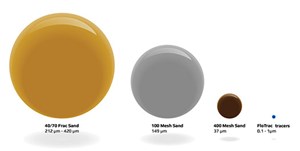Multi-stage Texas geothermal well to debut oilfield completion technologies
Ultra-high-resolution nanoparticle tracers, engineered for temperature stability of up to 2,000°F (1,093°C), will be deployed for the first time to map the inter-well flow communication of a multi-stage geothermal well, as part of a South Texas pilot project to be initiated later this year.
Beginning with the first of a planned multi-well geothermal development on the Texas Gulf Coast, the ultra-high-temperature tracer technology, which has been used extensively in stage-level flow profiling of unconventional oil and gas wells, will be used to map the flow path of injected fluid. This will ensure adequate heat transfer between injector and heated brine-producing wells. Drilling of the high-temperature, high-pressure (HTHP) test well will kick off the first-ever commercial-scale geothermal development in Texas.
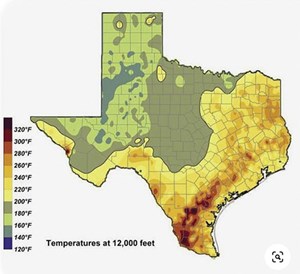
Along with now-routine well construction techniques, such as high-deviation tangents, horizontal well trajectories, multi-stage completions and closed-loop systems, the use of the smart nanoparticle tracers represents yet another step change advancement in the transfer of oil and gas technologies to the advancing geothermal sector. As with oil and gas wells, surface recovery of the specially tagged and non-radioactive tracers will provide precise flow measurements of conductive pathways from injection to production wells.
Data analysis will clearly identify stages with insufficient water flow that will require remediation, thus eliminating the guesswork that typically characterizes geothermal flow behavior assessments. Unlike multi-well unconventional developments, however, to facilitate maximum heat transfer, the resulting analytics from the next-generation tracer deployments will be used to promote, rather than mitigate, direct inter-well communication.
The well test and reservoir management plans for the Criterion Geothermal Systems Water Oak 1 (CGS-WO1) project will incorporate the tracer technology and data analysis to best inform optimum vertical and horizontal well spacing, injection rates and future full-field development strategy. Wells in the two-phase geothermal development, located alongside a major chemical manufacturing facility, are being drilled on repurposed oil and gas properties, Fig. 1.1
Taking notice of the intrinsic potential of orphaned petroleum acreage, the two-year-old Geothermal Technologies Office of the U.S. Department of Energy (DOE) in January awarded $8.4 million in grants to assess the geothermal opportunities within abandoned oil and gas wells, in support of the Biden administration’s ambitious goal to develop a carbon-free electrical grid by 2035.
GEOTHERMAL ANYWHERE
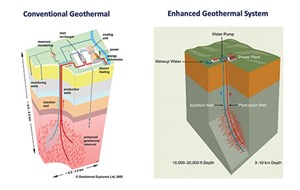
The most recent awards came on the heels of the DOE’s February 2021 granting of $46 million in funding for geothermal projects through the seven-year-old Frontier Observatory for Research in Geothermal Energy (FORGE) Initiative at the University of Utah. Since 2015, the DOE-operated FORGE initiative has served as a dedicated site where scientists and engineers develop, test and accelerate breakthroughs in enhanced geothermal system (EGS) technologies and techniques.
Unlike conventional geothermal systems, which exploit natural steam or extremely hot water trapped within deep rock formations, ESG is generally described as a methodology for injecting water at high pressure to re-open and promote the natural fractures in deep rocks and allow hot water or steam to flow into the comparatively larger-diameter producing wellbore, Fig. 2. The primary objective of an ESG is aligning the post-construction cost/kilowatt hour (KWh) of an onsite geothermal-driven power plant with competing renewable energy sources. The technology roadmap for the South Texas initiative is designed to bring the levelized cost of electricity (LCOE) down to $45/MWh, making it more than competitive in markets like Texas over the next few years, Fig. 3.
The objective of government-driven initiatives is to expand the well-documented exploitation of geothermal resources beyond areas with very high temperature gradients closer to surface. Globally, geothermal energy has been developed extensively in such diverse areas as Iceland and the Pacific Rim, while in the U.S., commercial geothermal developments have been concentrated mainly in California and Nevada, where similar in-situ conditions exist. Described as a low-medium enthalpy resource, the Water Oak 1 pilot well has estimated static bottomhole temperatures (BHT) ranging between 300°F and 350°F (150°C to 180°C) in the targeted sandstone reservoir found at a total vertical depth (TVD) of around 13,500 to 15,000 ft. With a planned a horizontal reach of 3,000 to 4,000 ft, the well is to be drilled to a measured depth (MD) of approximately 17,000 ft.
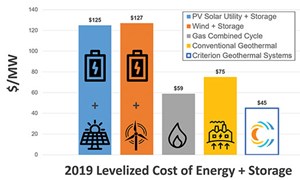
Along with drilling and flow testing of several additional production and injection wells, the second phase of the South Texas project includes the on-site construction of a scalable 20-megawatt (MWe) binary Organic Rankine Cycle (ORC) power generation plant with direct heat off-take, Fig. 4. Binary cycle plants use the heat from reservoirs of between 225°F and 360°F (107.2°C- 182.2°C) BHT to boil a working fluid, which is subsequently vaporized in a heat exchanger and used to power the generator.2
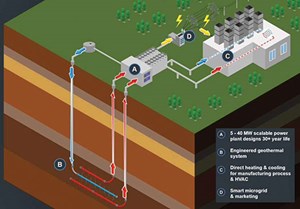
The preliminary completion target for the second phase, including the power plant, will occur approximately two years after a final investment decision (FID) on the second phase. Extended well tests are planned in parallel with the testing and commissioning of heat and power facilities.
The estimated 20 MWe output of the ORC facility would be sufficient to provide supplemental power to the petrochemical facility and, in the process, reduce Scope 1 and Scope 2 emissions. Specifically, the facility is designed to offset 1.8 million metric tons of carbon dioxide equivalent (CO2e) over the life cycle of the project. Once deployed, this solution is expected to be replicated across select areas of interest along the Texas Gulf Coast, where the industrial decarbonization impact is significantly greater.
ADAPTIVE TECHNOLOGY
To date, geothermal research, engineering, and development initiatives have largely concentrated on enhancing metallurgical integrity and developing technologies and improving practices capable of efficiently drilling and constructing wells through elevated temperature gradients and penetrating often-fractured rock with compressive strengths as high as 50,000 psi.
To minimize the temperature impact on downhole tools, the WO1 Phase 1 well, for instance, will employ continuous circulating equipment to minimize circulating temperatures during the drilling and completion phases. Moreover, an expected pore pressure gradient of approximately 0.7 to 0.8 psi/ft will require mud densities and pressure control equipment suitable for balanced or overbalanced drilling. In this over-pressured environment, managed pressure drilling (MPD) also may be deployed to improve the overall drilling performance.
Complementing the wholesale transition to multi-stage horizontal geothermal wells, more attention of late is focusing on stimulation and completion strategies and understanding the flow behavior in the targeted reservoir. While some geothermal operators plan to use fiber optics with Distributed Acoustic/Temperature Sensing (DAS/DTS) to develop flow profiles and aid in well placement, the technology is expensive and complex. The use of the nanoparticle tracers represents a much less costly and precise alternative to other diagnostic technologies, especially for long-term geothermal projects.
As demonstrated in hundreds of unconventional oil and gas wells, the FloTrac ultra-high-resolution nanoparticle tracer consistently quantifies the flow behavior of individual stages, while narrowing the wide economic chasm that previously made stage-level flow mapping inaccessible to mainstream wells.3,4 The non-intrusive nanoparticle-based tracers, combined with onsite diagnostics, are proven to deliver accurate and near real-time detection beyond the capabilities of conventional temperature-restricted chemical tracers and costly fiber-optic or DNA sequencing technologies.
The nanoparticle tracer portfolio comprises proprietary inert nanoparticles of 1 micron formulated for sub-atomic detection accuracy (Fig. 5), enabling exceptional surface recovery rates, which are proportionate to the production volume. Based on differentiating diagnostic field data, the technology exhibits a high level of precision in identifying non-producing and minimally producing stages and mapping field-wide inter-well communications.
When coupled with sub-atomic measurements, the tracers provide accurate and robust detection capabilities. Moreover, laboratory analyses incorporating big-data analytics, advanced 3D reservoir flow visualization and nanoparticle detection capabilities provide accurate, calibrated, and cost-effective completion and injection diagnostics results.
Assuring a low-cost structure ranked as a primary criterion at the onset of the development program, thereby leading to the engineering of a single tracer formulation that would be equally compatible with both oil and water.
SUBSURFACE VARIANCES
The transfer of now-routine oil and gas technologies and techniques notwithstanding, the geothermal projects differ widely in many respects, beyond the patently different production streams, injection rates and temperature stability requirements. For one thing, geothermal wells are constructed with comparatively larger-diameter wellbores, which are required to generate the flow volumes sufficient to compensate for the wide energy density disparity between hydrocarbons and hot water or brine.
The eccentricities extend to the deployment of the nanoparticle tracers. When pumped in an unconventional oil and gas well, the technology’s primary objective is detecting and characterizing production-draining, direct frac-to-frac communication between the original (“parent”) well and offset, or “child,” wells, thus providing the insight to enable remediation and guide the horizontal placement of subsequent wells on a multi-well pad.
That objective is reversed with the tracers’ deployment in a multi-stage geothermal well. Here, maximum heat extraction requires optimum and uniform communication between the injection well and every producing well, which impacts the injection strategy and project economics.
The CGS-WO1 completion program is designed to leverage matrix permeability, rather than relying entirely on induced fractures. It likely will feature a combination of both and with enough communication to achieve pressure support, but not so much as to be circulating injected fluid or tracer over a short period of time. The advanced tracer technology can carry much more information about the fractures in the reservoir, from the flow characteristics to the fracture’s conductivity.
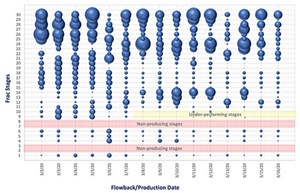
For perspective, Fig. 6 shows a high-resolution graphical representation of a stage-by-stage flow profile of a South Texas Eagle Ford shale well, in which 30 stages were monitored daily over a 21-day period. As with unconventional oil and gas wells, stage-level flow mapping of geothermal wells can significantly reduce costs and the environmental footprint by eliminating and/or remediating inefficient stages.
WO1 COMPLETION STRATEGY
The likely completion program incorporates a combination of packers and mechanically actuated sliding sleeves with screens for the high-rate production environment. The sleeves will be installed in tandem with a large-diameter production casing, with limited ID restrictions expected with the addition of handling subs and connections.
Given calculated reservoir permeabilities and porosities between 1 and hundreds of mD, natural pressures are expected to provide sufficient deliverability and a productivity index to allow for matrix flow with the tracers throughout the reservoir with minimal artificial stimulation required.
The well testing objectives include achieving a sustained rate of geothermal brine production at or above the target rates for an extended period. Before determining whether artificial lift and re-injection into the produced formation are required, pressure build-up and drawdown tests will be conducted during Phase 1 of the project to provide continual insight on reservoir volumes, limits and long-term deliverability.
A nanoparticle tracer customized for formation temperature will be injected with each stage during completion operations, as well as during the post-completion injection process in the injection well. In total, as many as 30 uniquely formulated tracers are scheduled for deployment, and designed tracer concentration will be in parts per million (PPM) from the total volume injected during each day.
A daily sampling and sub-atomic sample analysis is scheduled for all adjacent geothermal wells for inter-well flow mapping and diagnostics. The samples will be collected directly at the individual wellheads, which will enable detection of the best possible signal as the tracers are recovered from each well. The field team will be especially careful in handling high-temperature samples and will follow a rigorous sampling quality assurance/quality control (QAQC) protocol. As such, the intelligent nanoparticle tracers, in tandem with pressure interference analysis, will be deployed to deepen reservoir understanding.
FUTURE SCENARIO
Depending on the test well validation of current resource viability estimates, the power generation plant has the potential to be scaled up to deliver hundreds of MWe capacity. A positive evaluation of the potential could lead to the eventual drilling of more than 75 wells in the field and set the stage for further development throughout Texas.
As such, the nanoparticle tracers could play a pivotal role in the full asset development by providing precise diagnostic insight into future horizontal lateral landings and how to best space subsequent wells, optimize injection rates, promote best and most efficient cross-well communication and, importantly, more efficiently extract heat to generate power.
The deployment and advanced diagnostics of the intelligent tracer technology combined with horizontal drilling and multi-stage completions represents a novel and radical strategy to assist in the economics and efficiencies of geothermal development to enable this abundant, emission-free and reliable source to be completive with other energy sources.
SELECT REFERENCES
- Vivas, Cesar, Laura Ortiz and Saeed Salehi, University of Oklahoma; Danny Rehg, Denise Knight, Adam Bradley and Sean Marshall, Criterion Energy Partners; and Stephanie Perry, Geomark, “Technical and economic evaluation of a geothermal field in a sedimentary basin on the Texas Gulf Coast,”Proceedings of 47th Workshop on Geothermal Reservoir Engineering, SGP-TR-22, Stanford University, Stanford, Calf., Feb. 7-9, 2022.
- Dincer, Ibrahim, and Hasan Ozcan, “Binary geothermal power,” Comprehensive Energy Systems, 2018 1.17.3.3.2.
- Callahan, Denna, Tall City Exploration III LLC; and Talgat Shokanov and John Oliver, QuantumPro Inc.,” Stage-level flow assurance helps refine Permian field development strategy,” World Oil, September 2021
- Shokanov, Talgat, John Oliver and Prof. Adilkhan Shokanov, QuantumPro Inc., “Smart tracers yield stage-level insights,” American Oil & Gas Reporter, February 2021.
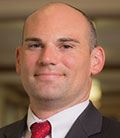

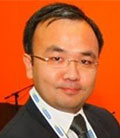

- Coiled tubing drilling’s role in the energy transition (March 2024)
- What's new in production (February 2024)
- Using data to create new completion efficiencies (February 2024)
- Digital tool kit enhances real-time decision-making to improve drilling efficiency and performance (February 2024)
- E&P outside the U.S. maintains a disciplined pace (February 2024)
- U.S. operators reduce activity as crude prices plunge (February 2024)

